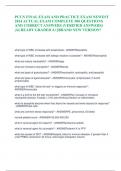PCCN FINAL EXAM AND PRACTICE EXAM NEWEST
2024 ACTUAL EXAM COMPLETE 500 QUESTIONS
AND CORRECT ANSWERS (VERIFIED ANSWERS)
|ALREADY GRADED A+||BRAND NEW VERSION!
what type of WBC increases with anaphylaxis - ANSWERbasophils
what type of WBC increases with allergic reaction or parasite? - ANSWEReosinophils
what are mature neutrophils? - ANSWERsegs
what are immature neutrophils? - ANSWERbands
what are types of granulocytes? - ANSWERneutrophils, eosinophils, and basophils
what are types of agranulocytes? - ANSWERmonocytes, lymphocytes (T and B
lymphocytes)
what type of WBC "starts the war" or triggers an immune response? -
ANSWERmonocytes
what is a shift to the left with neutrophils? - ANSWERan increase in immature
neutrophils (bands). if bands > 10% start thinking infection or inflammation
what do basophils become when they leave the vessels and enter tissues for response?
- ANSWERmast cells
what are common stress responses? - ANSWERPE, pneumonia, GI bleed
normal platelet count - ANSWER150,000-400,000
what is reversal agent for heparin? - ANSWERprotamine sulfate
what is reversal agent for coumadin? - ANSWERvitamin K or FFP
what are causes of DIC? - ANSWERsepsis, blood or immuno disease, if greater than 4
units PRBCs received in 24 hours, solid organ transplant, trauma
,what is DIC? - ANSWERunpredictable clotting, some progress to bleeding bc used up
all of clotting factors, always secondary diagnosis to something else
what are s/s of DIC? - ANSWERdusky fingers/toes (clotting in capillaries), bleeding
(gums, oozing of IV sites), unexplained petechiae/bruising
lab changes in DIC - ANSWER-decreased platelets < 100,000
-increased coags (PTT, INR, PT)
-decreased fibrinogen levels (protein precursor to fibrin which is essential to make the
clot)
-increased FSPs (things that make the clot)
-increased D dimer
how to treat DIC - ANSWERtreat clotting phase with heparin
treat bleeding phase with cyroprecipitate - blood product of choice for hemorrhage
related to DIC - gives pt back clotting factors AND fibrinogen
What is HIT? - ANSWERHeparin Induced Thrombocytopenia. platelets decrease 5-14
days after receiving heparin. more likely to be caused by low molecular weight heparin
(SQ). see unpredictable clotting, more common in venous.
what is HIT treatment? - ANSWERstop all heparin! including heparin flushes. stop
coumadin! don't want to give platelets because it will cause more clotting.
what is most common reason patients reject an organ/blood? - ANSWERthey develop
antibodies
what are s/s of hypoglycemia? - ANSWERpale, sweaty, cool/clammy, shaky, confusion,
vision changes (blurred or seeing spots)
what do cells start to break down when they dont have glucose for energy? what does
this produce? - ANSWERproteins and fats, ketones
what is DKA? - ANSWERmore commonly in type one diabetics who produce little to no
insulin. as glucose in blood increases, it causes osmotic diuresis and patient excretes
large volumes of urine. patient may become hypovolemic. patient will develop
ketoacidosis and lactic acidosis.
what s/s of DKA? - ANSWERblood sugar 250-800
sweet, fruity breath
postural hypotension
kusmol respirations (deep + labored) to decrease CO2 to attempt to normalize pH
nausea/vomiting
what are the hallmarks of DKA? - ANSWERhigh blood sugars
ketones in urine and blood
,acidosis with low bicarb
what is treatment for DKA? - ANSWERfluid volume resusitation and insulin drip
what kills DKA patient? - ANSWERhypokalemia
when can you stop insulin drip with DKA? - ANSWERwhen no more ketones in urine
what is HHS? - ANSWERhyperosmolar hyperglycemic state. more common in type two
diabetics. relative lack of insulin that leads to increase glucose production
what kills an HHS patient? - ANSWERsevere dehydration
what are s/s of HHS? - ANSWERthree Ps: polydipsia, polyurea, polyphasia
normal HHS blood sugar: 600-1200 (higher than DKA)
tongue looks like shoe leather
tenting of tissues
tachycardia
hypotensive
rapid and shallow RRs
what is treatment for HHS? - ANSWERfluid volume resusitation (8-12 L in first 24 hours)
and insulin drip with no bolus
what is diabetes insipidus? - ANSWERcomplete or relative lack of antidiuretic hormone
aka vasopressin
what are causes of diabetes insipidus? - ANSWERrenal or neuro:
nephrogenic DI where renal tubules are desensitized to effects of ADH
central DI where ADH not being produced by posterior pituitary gland
most commonly caused by trauma (typically head) or pituitary tumor
what is the response of DI? - ANSWERinability to concentrate urine, large urine volume
THINK DI = DRY
what are the s/s of DI? - ANSWERthirsty, polyuria, dehydration, tenting, dry mucus
membranes, tachycardia, hypotension, increased plasma osmolality, decreased urine
osmolality, increased sodium levels d/t dehydration, decreased specific gravity of the
urine
how to treat DI? - ANSWERgive vasopressin AKA ADH then fluid volume replacement
watch Is/Os and electrolytes
what is SIADH? - ANSWERmaking too much ADH causing decreased urine production
and increased urine concentration
SIADH = sodium swimming in water
, untreated can lead to water intoxication and death
s/s of SIADH? - ANSWERdecreased sodium levels
decreased blood osmolality
dark, concentrated urine
increased urine osmolality
late s/s: decreased LOC, seizure, coma
what causes SIADH? - ANSWERCNS dysfunction, head trauma, lung CA, patients
taking high doses of NSAIDs, chemo, big surgical patients
how to treat SIADH? - ANSWERfree water restriction, loop diuretics (lasix, bumex),
tetracycline abx or lithium (increased urine water excretion), 3% saline infusion to
replace sodium
watch Is/Os and sodium levels
what is a normal GFR? - ANSWER90-120 mL/min
what kind of dysrythmia is more common with posterior MI? - ANSWERatrial dysrythmia
What type of dysrhythmia commonly occurs with LAD MI? - ANSWERSecond Degree
Type II
What is the equation for Cardiac Output? - ANSWERCO = HR x SV (stroke volume)
what are the three components of Stroke Volume? - ANSWERpreload, afterload, and
contractility
how is preload measured? - ANSWERCVP
what is normal CVP in healthy person? - ANSWER2-6
what is starling's law? - ANSWERincreased stretch = increased volume = better EF
if wegive more volume that increases the stretch and contraction of the heart muscle
within physiological limits
what are three drugs used to mainupate HR? - ANSWER1. beta blockers
2. calcium channel blockers
3. digoxin
how to raise CVP? - ANSWER1. crystalloids - NS, LR
2. colloids - hetastartch, albumin
3. blood products




